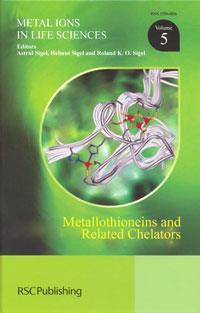Metallothioneins and related chelators
Metallothioneins and related chelators
Astrid Sigel, Helmut Sigel and Roland K O Sigel (eds)
Cambridge, UK: RSC Publishing 2009 | 514pp | ?150.00 (HB) ISBN 9781847558992
Reviewed by Peter Sadler

Metallothioneins were firstdiscovered over 50 years ago in horse kidney as small cysteine-rich proteins that appeared to detoxify cadmium. Since then they have been found in many other tissues, perhaps most intriguingly in the brain, and in many other organisms, including bacteria.
They play a natural role in controlling the storage, transport and delivery of metal ions, especially zinc and copper. Their coordination chemistry is fascinating: they promote metal thiolate cluster formation, contain bound metals with varying degrees of kinetic lability, and can couple cell redox status to metal uptake and release via cysteine thiolate oxidation.
This book (volume 5 in Metal ions in life sciences series) covers most of the wide field: the history, regulation of gene expression, bacteria, yeast and fungi, plants, fruit flies, earthworms and nematodes, aquatic organisms, vertebrates, and implications for toxicology and carcinogenesis. The novelty introduced into the metallothionein field by the late entry of bacteria and plants is notable: they brought histidine nitrogens as ligands in the metal cluster sites, sites previously dominated by cysteine sulfur only. In amongst the metallothioneins, and perhaps surprisingly, is a chapter on thioredoxins and glutaredoxins, although they do contain Cys-X-Y-Cys active site motifs. The final chapter is concerned with phytochelatins, the small cysteine-containing peptides related to glutathione.
Specialist review volumes such as this are not cheap, and therefore destined for libraries, but this series is a must for most bioinorganic research labs. The book will also be very useful for final year undergrads - an excellent topic for introduction to metal biocoordination chemistry. Perhaps one day we shall see the use of metallothioneins in medicine - could MTs hold the key to understanding intractable neurological disorders such as Alzheimer’s and Parkinson’s?












No comments yet